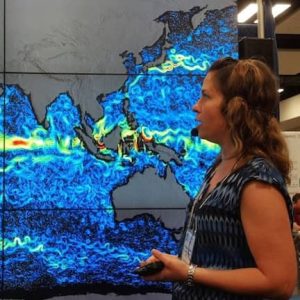Earth and Space Research (ESR) was begun thirty years ago, in 1995, as a small, independent team of scientists who believed there was a better way to do science. Founders Gary Lagerloef and Robin Muench envisioned a space that was collaborative, nimble, and deeply focused on discovery. Today, ESR has developed into a hub for innovative research in oceanography, meteorology, glaciology and polar studies, producing data that feeds applications such as global ocean circulation models, shipping forecasts, interpretation of ice cores, and predicting melt on polar ice sheets. ESR has always had public understanding of science at the heart of its mission, and is now expanding its community-based efforts into deep mentorship for youth in geosciences.
Established under the concept that an institution that serves its employees allows the employees to serve others, the center of ESR has always been its people. At the helm today is ESR’s president, Julian Schanze, who was preceded by Kathleen Dohan and Laurie Padman, who served in this role after Gary Lagerloef stepped down in 2014. Together, their stories represent ESR’s past, present, and future. Their stories reveal a shared commitment to discovering how the Earth System works and transforming those discoveries into actionable, human-centered science.
President (2014-2019)
 Kathleen Dohan’s journey with ESR began in 2007, when she moved to Seattle after studying at Scripps, for a postdoctoral position working with Gary Lagerloef and Fabrice Bonjean. Coming from a background in turbulence research and ocean data analysis, she found a natural fit with ESR working on the Ocean Surface Current Analyses Real-time (OSCAR) project. OSCAR uses satellite data and simplified physics to create global ocean current maps. This dataset, updated daily and publicly hosted by NASA, remains a core product of ESR today.
Kathleen Dohan’s journey with ESR began in 2007, when she moved to Seattle after studying at Scripps, for a postdoctoral position working with Gary Lagerloef and Fabrice Bonjean. Coming from a background in turbulence research and ocean data analysis, she found a natural fit with ESR working on the Ocean Surface Current Analyses Real-time (OSCAR) project. OSCAR uses satellite data and simplified physics to create global ocean current maps. This dataset, updated daily and publicly hosted by NASA, remains a core product of ESR today.
Dohan has watched ESR grow from a small team led by its founders to a bustling network of researchers, postdocs, and collaborators. The company’s growth has been organic, hosting a mix of scientists drawn in by shared curiosity and the freedom ESR offers outside the university system. “We just celebrated 30 years this year,” she says proudly, “and it still feels like a place where everyone rolls up their sleeves and gets involved.”
Part of ESR’s core culture is collaboration: everyone contributes to both research science and its related products as well as to the inner-workings of the company itself. As president, Dohan emphasized ESR’s collaborative culture and agility as a small research organization. Under her leadership, she successfully led the company through one of the longest government shutdowns, which required varied expertise across the company and complex compromises.
Looking forward, Dohan sees ESR’s future tied to both continued excellence in fundamental oceanography and new efforts to communicate ESR’s value to industry and policymakers. She believes that ESR’s data products have practical applications for fisheries, shipping, and disaster response, all areas where partnerships could open new funding avenues without compromising scientific integrity.
For Dohan, the future of ESR is about staying nimble, keeping the science high-quality, and finding creative ways to connect with the broader world. “We have to tell our story in a way that resonates outside of academia,” she says. “It’s not just data, it’s about helping people understand their changing planet.”
President (2019-2024)
 Laurie Padman joined ESR in 1997, after a decade at Oregon State University. He began his career in polar sciences as a postdoc working on Arctic turbulence data, and was hooked on cold climates after doing fieldwork in an Arctic ice camp in 1989. He joined ESR for a chance to contribute to Lagerloef and Muench’s collaborative vision while continuing to study polar oceans and ice. During Padman’s nearly four decades in polar science, his work has transitioned from fieldwork on Antarctic cruises and Arctic ice camps to modeling and satellite-based climate studies.
Laurie Padman joined ESR in 1997, after a decade at Oregon State University. He began his career in polar sciences as a postdoc working on Arctic turbulence data, and was hooked on cold climates after doing fieldwork in an Arctic ice camp in 1989. He joined ESR for a chance to contribute to Lagerloef and Muench’s collaborative vision while continuing to study polar oceans and ice. During Padman’s nearly four decades in polar science, his work has transitioned from fieldwork on Antarctic cruises and Arctic ice camps to modeling and satellite-based climate studies.
Padman has always been motivated by the joy of learning, and understanding the polar regions as complex systems that can only be properly understood through collaborations with diverse teams of scientists using their different insights from field data, satellites and modeling. He sees this approach as key to providing high-quality science and data products that are needed to ensure that critical climate science remains robust and actionable. As ESR President, he promoted the exploration of new skills and tools in ESR as a way to drive innovative science, keeping ESR relevant in rapidly changing terrain.
Padman’s vision for ESR is that it continues to provide an employee-centered home for researchers and science educators who thrive best in small, non-traditional environments. He believes that effective climate science at ESR requires the institutional support of people with diverse skills and research styles. At the same time, Padman encourages developing external collaborations to address key issues in the complex climate system and provide opportunities to mentor the next generation of climate scientists.
“The polar regions are changing fast,” Padman says, “and we need coordinated research to understand those changes.” For him, ESR’s role is to keep producing the gold-standard research and data that researchers around the world rely on — and to keep telling the story of why it matters.
President (2024-present)
 Under President Julian Schanze’s leadership, ESR is evolving into a more agile, adaptable organization, one that balances scientific rigor with responsiveness to emerging environmental and societal needs. While Schanze’s background in oceanography exemplifies ESR’s tradition of technical excellence and curiosity-driven research, his focus as president is on positioning ESR to thrive in a rapidly changing scientific landscape.
Under President Julian Schanze’s leadership, ESR is evolving into a more agile, adaptable organization, one that balances scientific rigor with responsiveness to emerging environmental and societal needs. While Schanze’s background in oceanography exemplifies ESR’s tradition of technical excellence and curiosity-driven research, his focus as president is on positioning ESR to thrive in a rapidly changing scientific landscape.
ESR is broadening its base of support beyond traditional federal funding, cultivating diverse partnerships and new funding streams that allow the organization to pursue innovative, cross-disciplinary work. From modeling the global hydrologic cycle to understanding the interplay between oceans, ice, and atmosphere, ESR scientists are applying their expertise to real-world challenges, those that link environmental processes to community resilience, sustainability, and the responsible stewardship of natural systems.
Education and outreach remain central to ESR’s mission. While ESR continues its legacy of outreach in schools and the broader public spheres, it has also expanded mentorship of youth and early-career researchers. Initiatives such as the Mount Baker Climate Laboratory, the ESR Summer Institute, and partnerships with Northeastern University – Seattle connects cutting-edge research with hands-on learning opportunities for youth and young professionals. These efforts underscore ESR’s belief that actionable science is not only about producing data but also about cultivating the next generation of scientists, engineers, and informed citizens who will carry that work forward.
Looking ahead, ESR seeks to strengthen its role as a bridge between science and society, applying observational insight and modeling expertise to help inform decisions about water, climate, and ecosystems in a changing world.
Though their paths to ESR and scientific backgrounds were vastly different, Kathleen Dohan, Julian Schanze, and Laurie Padman are united by a common purpose. They see ESR as more than a workplace. It has become a collaborative platform for innovation and curiosity about the natural world oriented towards real-world solutions, and a place where scientists can do their best work without losing sight of the big picture.
Their collective vision is clear: to maintain scientific rigor, expand ESR’s agility and capacity, train the next generation of scientists, and deepen public understanding of how a healthy ocean, atmosphere, and cryosphere are intertwined and integral to our shared future.